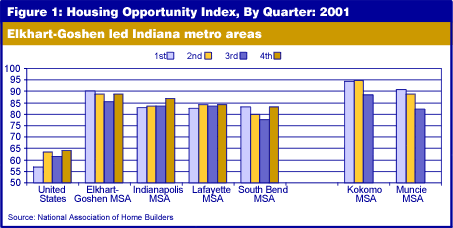Housing Affordability Stands High in Hoosier State
The National Association of Home Builders (NAHB) has released its latest report on housing affordability, covering the fourth quarter of 2001. NAHB gauges housing affordability with a measure called the Housing Opportunity Index (HOI), which is defined as the share of homes sold in an area that would be affordable to a family earning the median income for that area. The index thus has two major components, income and housing cost, which can vary considerably by region.
The national Housing Opportunity Index for the final quarter of 2001 was 64.1, meaning that 64 of 100 homes sold nationwide were affordable to families in the middle of the income distribution. NAHB also calculates the index for metropolitan areas which meet a minimum threshold for home sales in the quarter. In last year's fourth quarter, the Rockford, Illinois MSA led all metro areas with a Housing Opportunity Index of 95.8. At the opposite end of the spectrum, San Francisco was the least affordable metro area, with a paltry index score of 8.0. While median family income in San Francisco was 52 percent higher than the national figure, the median sales price for homes sold in the fourth quarter exceeded the national norm by almost 230 percent, pricing families of modest means out of the market.

Four Indiana metros made the list of "25 Most Affordable Metro Areas" in last year's fourth quarter, led by the Elkhart-Goshen MSA with a score of 88.9. Among the nation's largest metro areas, those with a population of one million or more, Indianapolis ranked highest on affordability for the second, third, and fourth quarters of 2001. In the most recent quarter, 87 percent of homes sold were judged to be within the means of the "average" family. Also making the top-25 list were Lafayette and South Bend, each with index scores over 80.
Two other Indiana metro areas have scored at or near the top of the affordability rankings in recent quarters, but a lack of sales data precluded an index calculation for the fourth quarter. The Kokomo MSA ranked #1 in the nation in the first two quarters of 2001, before slipping to #3 in the third quarter. Muncie held the #4 ranking in each of the first two quarters of 2001.
Most observers would agree that affordable housing is a desirable attribute for any area, but affordability may be a byproduct of economic distress. Rockford, for instance, experienced a 3.9 percent drop in nonfarm employment between December 2000 and December 2001. Over roughly the same period, Rockford's HOI increased 4.5 points, from 91.3 in the first quarter to 95.8 in the fourth quarter. Two metro areas with far lower HOI scores-San Jose, California and Portland, Oregon-also experienced job losses in 2001, and large jumps in HOI. In San Jose, nonfarm employment fell 4.3 percent in the 12 months preceding December 2001, with a corresponding HOI increase of 3.3 points, from 14.5 to 17.8. In Portland, HOI grew by 5.6 points (to 45.8) on a 2.4 percent decline in employment.
In the case of Kokomo, median family income is slightly higher than the national median, but low housing prices really drive the metropolitan area's high index score. In the second quarter of 2001, when the Kokomo MSA achieved an HOI score of 94.7, median family income was about $5,000 above the national figure, but the area's median sales price was $57,000 below the U.S. median.
